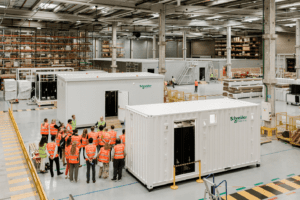Introduction: This past April, I had a chance to attend Data Cloud Monaco for the first time in many years, and it was great to connect with many industry professionals and have in-depth conversations on a wide range of industry topics. One key topic was edge computing and the amount of data processed outside of traditional data centers in the coming years.
Overall, there was a consensus: the proliferation of connected devices & products that drive business-critical applications is increasing exponentially. To safeguard this investment, organizations require a robust physical IT infrastructure.
To dive deeper into this expanding market trend, I caught up with Mustafa Demirkol, the Vice President of Offer Management for Schneider’s Data Center Solutions.
Joris Verdickt: Hello Mustafa, glad to talk to you again. Tell us more about what customers say about edge computing and how their business responds.
Mustafa Demirkol: Good to see you too. With the sheer growth of data and the need for data to be processed in real time for operations, there is an increase in pressure to place compute power on site. This has surely jump started the digital transformation.
JV: Yes, I’ve heard that latency is an issue with digitalization with the large amounts of data that needs to be processed quickly. But how can IT departments rapidly, efficiently, and cost-effectively add edge computing data centers at multiple warehouses, factories, healthcare facilities, or construction sites? In particular, many businesses might need more skills or resources to deploy and manage edge computing data centers.
MD: Yes- all valid points that customers are vetting. Organizations need access to practical solutions that help improve business operations and allow for expansion while staying within budget. This is where prefabricated modular data centers come in.
Prefab modular data centers are not necessarily a new “offer” – they have been around for decades, and Schneider Electric has been building them for nearly 20 years. Yet, our customers are asking for more. They want to make it easier to configure, quote, and buy a fully integrated modular solution. They ask for a configured-to-order (CTO) solution from a traditionally engineered-to-order (ETO) solution. We are listening to our customers’ needs and are now offering a new solution that meets these criteria. It is called the Easy Modular Data Center All-In-One offer.
JV: Over the past few years in my current role, I’ve heard that feedback quite a lot from customers, so I’m glad we were able to turn that input into an actual offer. So, what makes this “Easy Modular Data Center All-In-One” different from the traditional All-In-One?
MD: To put it simply – if you were to walk into our “Easy” offer vs. the traditional offer, you might not recognize anything drastically different. Each Easy Modular Data Center All-in-One utilizes Schneider’s Easy range of racks, power distribution units (PDUs), and uninterruptible power supplies (UPSs). We’ve created “Base Designs” covering the broadest range of configurations with redundancy options. These base designs are pre-defined, pre-engineered, and priced to a standard price list.

JV: Could a customer request similar types of UPS & Racks from Schneider in a traditional Modular offer?
MD: Sure, they can. But if they deviate away from the base designs, it does drive the complexity of the solution. We designed the offers to have multiple common parts and sub-components, allowing us to have a more manageable stocking plan and faster integration time. In years past, our reference designs were just that – references. But we have evolved these Easy Offers to be associated with firm costs and production. This approach allows us to be faster to the market and treat this more like a ‘transactional product’ than a typical ETO Modular solution.
JV: This is quite an interesting concept, Mustafa. This works well for customers who don’t have a large IT staff and have increasing edge demands or for customers looking to have a consistent, repeatable solution across multiple geographies.
MD: One example that illustrates this growing edge need is in the Life Science sector. Life Science companies have been at the forefront of solving health crises, such as Covid 19, and have to innovate and leverage technology to its fullest potential. Therefore, uptime is mission-critical, particularly in R&D labs. Our Easy Modular All-In-One data center offers the physical infrastructure needed to support data processing. It includes power protection to deliver stable and reliable power to servers, storage, and networking, which prevents unplanned downtime. This solution also offers a smaller footprint for distributed sites with less space for IT equipment.
JV: That’s a key point – space constraints play a significant role in selecting a Modular Data Center built off-site. But couldn’t a client decide to buy individual components to build their own data center?
MD: Yes, clients often decide between a traditional “stick-built” data center and prefabricated solutions. But one of the critical business drivers that leads many clients to choose a modular prefabricated solution is the ability to mitigate risk and utilize a consistent labor force in a controlled environment like a factory. When those sub-components are pre-integrated and tested off-site and then delivered in a modular data center, it helps speed up the deployment process. In addition, all our Easy Modular All-In-One solutions go through an End of Line Factory test before they ship, so we can ensure a high-quality level that Schneider customers expect.
JV: This is clear – a prefab solution helps to manage risk. I imagine an Easy Modular All-In-One could work for other key segments that Schneider supports, correct?
MD: Of course. Our first few projects for the Easy Modular All-in-One globally were not typical data center specific segments. Rather, we provided solutions for retail, warehouse logistics & distribution, transportation, and oil & gas segments. These industries have a growing IT consumption need that is not satisfied simply by having their IT racks hosted in a colocation or within a hyperscale data center. Instead, they need to get access to those applications, and the localized network is that crucial connector.
JV: And speaking of the network, how can users manage these modular data centers? What software is available?
MD: Each Easy Modular Data Center can include our IT Expert or Data Center Expert Software, and users can add access control and Netbotz monitoring if they choose. In addition, our customers can choose a service plan resourced by our knowledgeable field service team to monitor and maintain their modular data center installation. This service provides peace of mind to our clients, especially those whose main areas of business are not IT-centric.
JV: I’m glad you brought up the service aspect. A strong operational plan ensures business continuity from start to finish. Any last comments or thoughts on the Easy Modular All-In-One before we conclude our interview?
MD: Overall, the Easy Modular All-In-One solution is designed to address speed, predictability, and cost – we have a solution that can be built in parallel to site construction that is on average 15% less than the comparable ETO equivalent. The production cycle timing can be shortened because of standardization in the base design. It’s the ideal solution for edge computing deployments.
Conclusion: IT infrastructure continues to evolve rapidly in response to increased connectivity and digital transformation. To keep up with this demand while also addressing uptime and operational efficiencies, organizations can turn to solutions that make it easy to scale and are customized to their unique edge computing needs. Learn more about Easy Modular All-In-One solutions to see if this approach is a fit for your evolving IT infrastructure needs.


